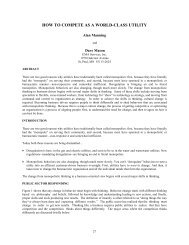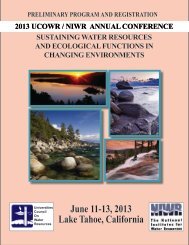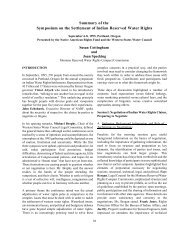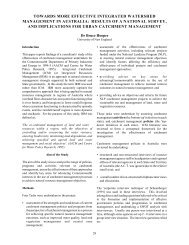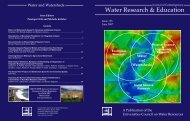52Mitchell<strong>of</strong>ten took three to four years to complete,resulting in some people wondering about theirpractical value <strong>and</strong> whether the time to completethem could be reduced, (2) recommendationsusually were numerous <strong>and</strong> unprioritized (furtherexacerbated because, once a plan was completed,the team which had prepared it dispersed, leavingfew people who could provide insight aboutpriorities), <strong>and</strong> (3) insufficient attention was givento implementation. The last point was particularlynoticeable because planning teams normally didnot engage in systematic <strong>and</strong> ongoing dialoguewith the agencies <strong>and</strong> others responsible for takingaction regarding the recommendations.Starting from the experience with the OntarioConservation Authorities, <strong>and</strong> from the federalprovincialcomprehensive basin plans, combinedwith other initiatives across the country, reflectionled to lessons learned. These lessons now providea foundation for IWRM in Canada.Lessons Learned <strong>and</strong> Their Implicationsfor IWRMImportance <strong>of</strong> a VisionIWRM is a means to an end. Consequently, itis important to have a clear vision or directionabout a desired end state for a catchment or riverbasin. IWRM then becomes one means to assistin achieving the desired end state.A vision identifies a future state believed to bemore desirable than the present state. Without avision or direction, it is difficult to determine whichparts in the basin need to be brought together into awhole, <strong>and</strong> who should be working together.Developing a shared vision is normallychallenging because many values, interests <strong>and</strong>needs that exist in a river basin or catchment needto be reconciled. Notwithst<strong>and</strong>ing this challenge,if there is no sense <strong>of</strong> direction or well understoodends, IWRM will not be able to create one. Thus,planners <strong>and</strong> managers have learned that IWRMwill not be effective without a vision. Worse,IWRM may be discredited because it did notgenerate a vision, something is was never intendedto do.In developing a vision, it has been learned thatwe need to distinguish among what is probable,desirable, <strong>and</strong> feasible because the most probablefuture may not be the most desirable future. Inaddition, a desirable future may not be feasible.It is exactly in order to determine the desired<strong>and</strong> feasible future condition that planners <strong>and</strong>managers create a vision.Sharpening FocusThe long time taken to complete comprehensiveriver basin <strong>and</strong> similar plans led to rethinkingabout how to interpret a systems, ecosystem orholistic approach. The value <strong>of</strong> looking at thesystem represented by a river basin, its componentparts, <strong>and</strong> the relationships among the partswas always understood so that the connectionsamong water, l<strong>and</strong>, <strong>and</strong> other resources could beaddressed systematically, with attention also givento economic, social, <strong>and</strong> environmental aspects<strong>of</strong> the watershed. However, it was learned that itwas unnecessary to examine every component <strong>and</strong>every relationship, since each was not significantin accounting for variability in system behavior.And certainly, each was not amenable to beingmanaged.As a result, while the value <strong>of</strong> a systems,ecosystem, or holistic approach continued to beappreciated, it was learned that it was neithernecessary nor desirable to take a comprehensiveperspective if that meant studying everycomponent <strong>and</strong> relationship. Instead, it waslearned that greater value would occur if attentionfocused on the key components <strong>and</strong> relationshipsaccounting for the greatest variability in systembehavior, provided these are also amenable tomanagement interventions. It was this lessonthat led to increasing reference to an “integrated”rather than a “comprehensive” approach becausethe former maintained the benefits <strong>of</strong> a systemsapproach (considering the watershed as a system,its parts <strong>and</strong> their interrelationships), but wasmore selective by focusing on only those parts <strong>and</strong>relationships judged to be most significant from amanagement perspective.This shift in interpretation <strong>and</strong> approach directlyaddressed the concerns that arose in the 1970sabout comprehensive river basin plans strivingto undertake too much by examining all variables<strong>and</strong> relationships. Negative consequences <strong>of</strong> thecomprehensive approach include inordinateamounts <strong>of</strong> time needed to complete studies <strong>and</strong>UCOWRJOURNAL OF CONTEMPORARY WATER RESEARCH & EDUCATION
IWRM In Practice Canada53develop basin plans. The tighter focus <strong>of</strong> anintegrated interpretation, it is believed, increasesthe likelihood that analysis <strong>and</strong> planning can becompleted in a shorter period <strong>of</strong> time, <strong>and</strong> generatea smaller set <strong>of</strong> more relevant <strong>and</strong> prioritizedrecommendations.Significance <strong>of</strong> Spatial ScaleConsistent with taking an integratedinterpretation, analysts, planners <strong>and</strong> managershave learned that different levels <strong>of</strong> detail shouldbe sought, depending on spatial scale. Thisis exemplified by the approach that emergedin Ontario as a result <strong>of</strong> assessing catchment<strong>and</strong> subcatchment planning experiences in thatprovince (Credit Valley Conservation, Gr<strong>and</strong>River Conservation Authority, <strong>and</strong> Toronto RegionConservation Authority 2002). The conclusion wasthat planning <strong>and</strong> management should focus on one<strong>of</strong> four different scales: watershed, subwatershed,tributary, <strong>and</strong> site. In moving across scales, thekinds <strong>and</strong> amount <strong>of</strong> data to be collected shouldchange, “with the level <strong>of</strong> detail increasing asthe size <strong>of</strong> the planning area decreases.” Ideally,what is done at each stage provides “direction <strong>and</strong>information” for the next lower level.The four spatial levels <strong>of</strong> planning, reflectingdifferent levels <strong>of</strong> detail for information, are:1. Basin or catchment plans: Covering largeareas, these plans include goals, objectives,<strong>and</strong> targets for the entire basin, <strong>and</strong> documentresource <strong>and</strong> environmental problems. They alsoprovide catchment-wide policy for protectingsurface <strong>and</strong> ground water, natural features,fisheries, open space systems, terrestrial <strong>and</strong>aquatic habitats, <strong>and</strong> other important features.If resources are degraded, restoration needsare addressed. These plans usually also specifywho will do what by when, how it will be done,<strong>and</strong> what reporting will occur.2. Subcatchment plans: Relative to basinplans, enhanced detail is provided to allowlocal environmental issues to be addressed.Goals, objectives, <strong>and</strong> targets to managethe subcatchment are identified. In addition,plans give attention to the form, function,<strong>and</strong> linkages <strong>of</strong> the natural system;environmentally sensitive or hazard l<strong>and</strong>s;3.4.areas where development may be permitted;Best Management Practices such as aggregateextraction, development servicing <strong>of</strong> wood lotsfor agriculture; direction <strong>and</strong> consistency forapproval <strong>of</strong> development for municipalities;cumulative impacts <strong>of</strong> changes on the naturalenvironment; <strong>and</strong>, implementation <strong>and</strong>monitoring plans. Subcatchment IWRM plansare custom-designed for local conditions <strong>and</strong>concerns. Recommendations may subsequentlybe incorporated into <strong>of</strong>ficial l<strong>and</strong> use plans,secondary plans, growth management plans,or other municipal planning instruments.Tributary plans: These are prepared to guideproposals for significant l<strong>and</strong> use changessuch as proposals for subdivisions, intensiveagriculture or industrial estates. These usuallycover an area between 2 to 10 sq km. Ideally,the boundaries <strong>of</strong> a tributary plan match thedrainage basin <strong>of</strong> a tributary, but in practicethis does not always occur. Tributary plansnormally document the environmentalresources; establish environmental protectiontargets for ground <strong>and</strong> surface water, aquatic<strong>and</strong> terrestrial communities <strong>and</strong> streammorphology; identify Best ManagementPractices, including those for stormwatermanagement; define or refine areas to beprotected <strong>and</strong>/or restored; identify locationsfor future stormwater management facilities;<strong>and</strong> identify future site-specific studies <strong>and</strong>monitoring needs. Recommendations fromtributary plans usually appear in secondaryl<strong>and</strong> use plans, <strong>and</strong> in <strong>of</strong>ficial l<strong>and</strong> use planamendments.Environmental site plans: These provide detailson proposed environmental <strong>and</strong> stormwatermeasures, <strong>and</strong> are usually submitted alongwith other plans for grading, erosion/sedimentcontrol <strong>and</strong> site servicing. Typical features aredetailed designs for stormwater managementfacilities; detailed designs for environmentalrestoration works (e.g., stream protectionworks); identification <strong>of</strong> constraints such assignificant wood lots, wetl<strong>and</strong>s or hazardl<strong>and</strong>s; sediment <strong>and</strong> erosion control plans;detailed geotechnical <strong>and</strong> water resourcereports; delineation <strong>of</strong> grading limits <strong>and</strong>JOURNAL OF CONTEMPORARY WATER RESEARCH & EDUCATIONUCOWR
- Page 3:
Journal of ContemporaryWater Resear
- Page 6 and 7: 2Bruce Hooperinstitutional, and tem
- Page 11 and 12: IWRM: Governance, Best Practice, an
- Page 13 and 14: IWRM: Defi nitions and Conceptual M
- Page 15 and 16: IWRM: Defi nitions and Conceptual M
- Page 17 and 18: IWRM: Defi nitions and Conceptual M
- Page 19: IWRM: Defi nitions and Conceptual M
- Page 22 and 23: 18Cardwell. Cole, Cartwright, and M
- Page 24 and 25: 20Mostert26 water boards responsibl
- Page 26 and 27: 22MostertTable 1. Third National Wa
- Page 28 and 29: 24MostertImplementationThe ambitiou
- Page 30 and 31: 26MostertBiswas, A. K. 2004b. Respo
- Page 32 and 33: 28UNIVERSITIES COUNCIL ON WATER RES
- Page 34 and 35: 30Ashton, Turton, and Rouxresource
- Page 36 and 37: 32Ashton, Turton, and Rouxassumptio
- Page 38 and 39: 34Ashton, Turton, and RouxEffective
- Page 40 and 41: 36UNIVERSITIES COUNCIL ON WATER RES
- Page 42 and 43: 38Hussey and Doversin water policy
- Page 44 and 45: 40Hussey and Dovers1994 Council of
- Page 46 and 47: 42Hussey and Doversestablished Thes
- Page 48 and 49: 44Hussey and DoversTable 1. Typolog
- Page 50 and 51: 46Hussey and Doversassessment appro
- Page 52 and 53: 48Hussey and Doverspolicy goals.Bey
- Page 54 and 55: 50Hussey and DoversFrawley, K. 1994
- Page 58 and 59: 54Mitchelltree preservation plans;
- Page 60 and 61: 56UNIVERSITIES COUNCIL ON WATER RES
- Page 62 and 63: 58Genskow and Borna series of chall
- Page 64 and 65: 60Genskow and BornTable 1. Watershe
- Page 66 and 67: 62Genskow and Bornthe first Dungene
- Page 68 and 69: 64Genskow and BornWashington, DC.Ko
- Page 70 and 71: 66Green and Fernández-BilbaoWithin
- Page 72 and 73: 68Green and Fernández-Bilbaosubjec
- Page 74 and 75: 70Green and Fernández-Bilbaoinflue
- Page 76 and 77: 72Green and Fernández-BilbaoBerbel
- Page 78 and 79: 74UNIVERSITIES COUNCIL ON WATER RES
- Page 80 and 81: 76BallweberEstablish AdvisoryCommit
- Page 82 and 83: 78Ballweberattributes in others (Ch
- Page 84 and 85: 80UNIVERSITIES COUNCIL ON WATER RES
- Page 86 and 87: 82Barreiraand ground water. To this
- Page 88 and 89: 84Barreirawith other states for int
- Page 90 and 91: 86UNIVERSITIES COUNCIL ON WATER RES
- Page 92 and 93: 88Davis and ThrelfallResource Manag
- Page 94 and 95: 90Davis and ThrelfallTable 2. Thirt
- Page 96 and 97: 92Davis and Threlfallby regional an
- Page 98 and 99: 94Davis and Threlfallenforcement, a
- Page 100 and 101: 96Davis and Threlfallhusbandry prac
- Page 102 and 103: 98Davis and ThrelfallNew Zealand: T
- Page 104 and 105: 100UNIVERSITIES COUNCIL ON WATER RE
- Page 106 and 107:
102Lamoree and van SteenbergenIt is
- Page 108 and 109:
104Lamoree and van Steenbergenand n
- Page 110 and 111:
106Lamoree and van Steenbergeninter
- Page 112 and 113:
108BourgetWorks Planner Capability
- Page 114 and 115:
110Bourgetwith over 600 people resp
- Page 116 and 117:
112Bourgetgovernment’s intrusion
- Page 118 and 119:
114Bourget4.management, drought man
- Page 120 and 121:
116McKayFigure 1. The four paradigm
- Page 122 and 123:
118McKay4. Paradigm 4 (which commen
- Page 124 and 125:
120McKaythree main functions:1. ass
- Page 126 and 127:
122McKayState Implementation of the
- Page 128 and 129:
124McKayTable 2. Corporate governan
- Page 130 and 131:
126McKayFigure 4. Qu. 26 - The ESD
- Page 132 and 133:
128McKayFigure 7. Qu.93- This organ
- Page 134 and 135:
130McKayBrundtland Report. 1987. Ou
- Page 136 and 137:
132UCOWR BOARD OF DIRECTORS/COMMITT
- Page 138 and 139:
134BENEFITS OF UCOWR MEMBERSHIPThe
- Page 140 and 141:
136Past Issues of the Journal of Co
- Page 142 and 143:
138Academic Organizations Membershi
- Page 144 and 145:
140Individual Membership Applicatio
- Page 146 and 147:
Universities Council on Water Resou
- Page 148:
Integrated Water Resources Manageme



